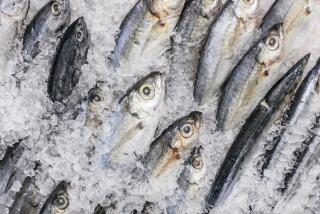State’s Fastest Growing Agricultural Product : Louisiana Crawfish Farms Boom
- Share via
BREAUX BRIDGE, La. — When Louisiana State University started studying ways to grow crawfish--the succulent, spiny denizens of Louisiana’s bayous--researchers kept hearing about what a waste of time it was.
“People smiled pleasantly about our efforts,” recalls James W. Avault, professor of fisheries at LSU’s agricultural center in Baton Rouge. “But they said we don’t need farming when we have plenty of crawfish in the wild to eat.”
But “Dixie lobsters”--also known as mudbugs, crawdads, creek crabs and crayfish--are now Louisiana’s fastest-growing agricultural product, in sixth place behind soybeans, rice, wheat, sugar cane and sorghum.
“The Louisiana crawfish industry has a tremendous potential,” Avault said. As recently as four years ago, he said, 98% of the crawfish harvested in Louisiana was consumed within the state. Last year, however, 10% of the crop was shipped throughout the United States and to Europe.
Half of the entire state of Louisiana is one big network of swamps, marshes, bayous and rivers, which would seem ample to provide enough wild crawfish to meet growing demand. But the wild crop isn’t always predictable. So, led by researchers at LSU, an increasing number of acres have been given over to pond farming to ensure a stable supply.
In 1970 there were only 3,000 acres in crawfish ponds in the state. The acreage of ponds more than doubled from 50,000 acres in 1980 to 110,000 acres in 1984.
Wild Ones From Swamp
Last year, a total of 100 million pounds of crawfish were harvested, half from ponds and half in the wild. Most of the wild crop comes from the 100-mile-long, 20-mile-wide Great Atchafalaya Swamp.
The farmers and fishermen were paid an average of 50 cents a pound for whole live crawfish last year, representing a $50-million industry at the dockside level alone. Retail prices are much higher, with Louisiana markets selling the meat for $4 to $7 a pound, depending on the time of year and availability.
Roy Robin, owner of Bayou Land Seafood of Breaux Bridge--known as the crawfish capital of the world--buys his “Dixie lobsters” from farmers who set funnel-shaped wire traps in shallow ponds and from fishermen who trap the crawfish in the wild.
Robin’s plant is one of the biggest in the state. There, the 3-to-5-inch-long crawfish are boiled and peeled, and the edible meat is removed from the tails. Last year, Bayou Land Seafood processed 2 million pounds of crawfish, shipping the meat to restaurants and seafood dealers in a dozen states, including California.
“The beauty of the crop as I see it,” Avault said, “is that it is a gourmet item at a price the average citizen can afford, a succulent, tender, tasty food much like lobster but smaller and sweeter.”
Crawfish meat shows up in Louisiana’s ethnic delicacies that have been prepared for generations by blacks and Cajuns. Now, on the crest of the increasing popularity of Louisiana cooking, restaurants across the nation are featuring such dishes as jambalaya, gumbo, crawfish bisque, crawfish Creole and crawfish remoulade.
Low-Cal, High Nutrition
“Crawfish is low in calories, high in nutritive value,” said Jane Barnett, editor of the quarterly magazine Crawfish Tales, a trade publication published by the Louisiana Crawfish Farmers Assn. in Lafayette, La.
Producers, processors and the Louisiana State Agricultural Department “are just beginning to promote crawfish nationwide,” she said. “A few franchise food chains are starting to serve crawfish. There’s a lot of excitement here.”
For the past 20 years LSU has been the world’s leading crawfish research center, with eight resident scientists devoting full time to research in labs and at 150 experimental ponds.
Their research in pond farming has had a side benefit for the state’s rice farmers, many of whom are now “double-cropping” with crawfish to help them through a world rice glut and low prices.
After the rice is harvested in the fall, the paddies are flooded and stocked with wild crawfish, which eat the stubble of the harvested rice. Later in the year, when the new rice crop is starting to grow, the female crawfish burrows into the black Louisiana clay, where she lays an average of 400 eggs. Once a pond is stocked, the crawfish continue to reproduce season after season.
The growth of the crawfish crop is already outpacing that of another, more common fresh-water inhabitant. “The 110,000 acres of crawfish is greater than the total combined acreage devoted to catfish farming in the United States at this time,” Avault said. “And we have only just begun.”
More to Read
Sign up for Essential California
The most important California stories and recommendations in your inbox every morning.
You may occasionally receive promotional content from the Los Angeles Times.













